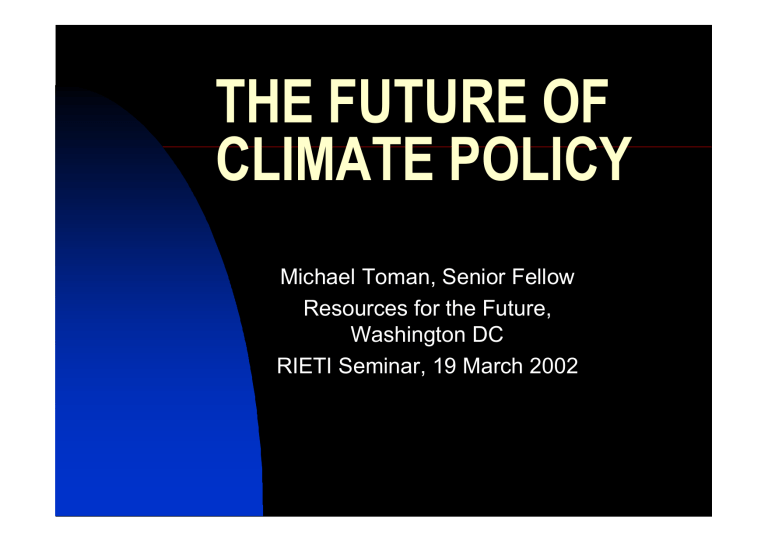THE FUTURE OF CLIMATE POLICY Michael Toman, Senior Fellow Resources for the Future,

THE FUTURE OF
CLIMATE POLICY
Michael Toman, Senior Fellow
Resources for the Future,
Washington DC
RIETI Seminar, 19 March 2002
Introduction
n
Climate change is a risk requiring a variety of actions, including some
GHG emissions mitigation n
Potential economic and social impacts of climate change:
Impacts of
Climate Change:
n n n n
Reduced productivity of natural resources (agricultural yields, timber harvests, water resources)
Damage to human-built environments
(coastal flooding, damages from increased storms and floods)
Risks to life and limb (heat waves, storms, contaminated water, tropical diseases)
Damage to natural landscapes, wilderness areas, habitats biodiversity
Impacts of
Climate Change
n n n n
Substantial uncertainty about magnitude of these effects
Key factor is extent of adaptation to climate change
Developing countries are more vulnerable than developed countries, though all countries face some degree of vulnerability
Possibility of highly nonlinear impacts
(climate catastrophe)
Policy Setting
n n n
1992 United Nations Framework
Convention on Climate Change
(UNFCCC)
Article 2: objective is to stabilize GHG concentrations within a time frame that would prevent “dangerous” human damage to the climate system
Article 3: precautionary risk reduction should be guided by equity across time and wealth levels, as expressed in the concept of “common but differentiated responsibilities”
Policy Setting
n
Article 4: nations should cooperate to improve human adaptation and mitigation of climate change through financial support and lowemission technologies n
Articles 3 and 4: use of costeffective response measures
Policy Setting
n n n n
1997 Kyoto Protocol:
Industrialized “Annex B” countries
(known in the 1992 convention document as “Annex I” countries) agreed to legally binding reductions in net GHG emissions averaging about 5% -- large relative to business as usual
No numerical targets for the emissions of developing
Several flexibility mechanisms – international emissions trading, multiple gases and sinks
Bush Rejection of Kyoto
n
Uncertainty about the severity of climate change risk n
Concern about the cost to the economy n
Desire for action by developing countries
Other National
Responses
n
Europe: Bloc-wide emissions trading n
Japan: voluntary measures, efficiency standards, sequestration n
Developing countries: some embrace of Clean Development
Mechanism (emission credit creation)
Bush Climate Policy
n
Reducing the GHG intensity of
GDP by 18 percent relative to business as usual by 2012 (100MT less carbon by 2010, 500MT less over the decade) n
Voluntary "challenges" to certain sectors for improved performance n
Some tax breaks for the adoption of lower-carbon technologies
Bush Climate Policy
n
Expanded capacity for the private sector to create tradable "early emission reduction credits" that would recognize voluntary action, with some unspecified prospect of some tangible reward for such action later
Bush Climate Policy
n
The possibility of some revision in current vehicle fuel economy regulations n
An assertion that more serious action would be seriously considered if by 2012 the abovementioned goal was not being met
Basic Economics of
Optimal Climate Policy
n n
1. There needs to be a balance of concern between the potential for irreversible negative consequences of climate change and the costs of misplaced mitigation investment.
2. As part of a policy portfolio, a gradual but purposeful approach to the implementation of GHG control targets to take advantage of cost savings and opportunities for learning has many desirable features.
Optimal Climate Policy
n n n
3. Well-designed, cost-effective incentive-based GHG mitigation policies are essential.
4. There are opportunities for devising and deploying improved technology, at relatively low cost, for GHG abatement -but technology solutions are not a panacea.
5. Climate policies should be coupled to broader economic reform opportunities and other environmental policies to maximize win–win opportunities.
Optimal Climate Policy
n n
6. To address domestic political problems arising from the distributional impacts of GHG policy, efforts should be undertaken to compensate the greatest number of real losers with the least waste.
7. A greater emphasis is needed on price-based approaches over strict quantity targets in the short to medium term to manage the risk of uncertain response costs.
Optimal Climate Policy
n
8. Coherent international architecture is key to success – serious discussion is needed of common ground for common but differentiated participation of developed and developing countries based on shared burdens and mutual benefit.
Optimal Climate Policy
n
9. Adaptation measures need to be substantially strengthened, especially in developing countries.
Economic Principles and Kyoto Protocol
n
Broad versus narrow participation n
Gradual and long-term versus abrupt and near-term abatement n
Emissions control versus cost control n
Clear versus still-developing policy mechanisms, incentives
Strengthening US
Climate Policy
n
Key policy problem is not modest initial emissions control target n
Major domestic policy weakness is lack of credible and effective mechanisms, reliance on tax preferences
Strengthening US
Climate Policy
n
Alternative approach: commit today to a modest but mandatory emissions target and control program by 2006 absent significant progress in emissions control n
Implement controls cost-effectively through comprehensive emissions trading (upstream where possible)
Strengthening US
Climate Policy
n
Limit cost risk with “safety valve”
(government issues more permits on demand at fixed ceiling price) n
Use innovative strategies to allocate permits to maintain efficiency and political feasibility
(Professor Goulder) n
Increase basic R&D spending
Strengthening US
Climate Policy
n
Policy will require political courage to raise energy prices, but no other way is effective and credible and economic impact can be kept small through gradual approach n
Limit reliance on “early reduction credits” to avoid gaming (“anyway tons”)
THE POST-2012
INTERNATIONAL
CHALLENGE
n
Bush approach does nothing to address the longer term: stricter emission targets, broader developing country participation n
Removal from Kyoto process makes it hard for the US to reengage, exercise leadership
Further Annex B targets
n
Policy split between US and
Europe will lessen as Europe struggles to implement its own binding policies, meet its target(s) n
Need international agreement on a gradual acceleration of emission control targets n
Can’t determine independent of developing country participation
Developing Country
Participation
n n
Ignoring principle of common but differentiated responsibilities is counterproductive
Any credible “graduation plan” must respect developing country self-interests n
Must also avoid unrealistic income transfers from current Annex B countries
Developing Country
Participation
n
Initial steps: expand Clean
Development projects, even if baselines and credit accounting are imperfect – provides knowledge and technology transfer, serves host country interests n
Explore other cost-effective ways for enhancing technology transfer
Developing Country
Participation
n n
Longer term: simple “equity rules
(grandfathering, equal per capita entitlement) are useless – provide too little to one group or another
Need to explore more complex graduation criteria for developing countries: “growth baselines” for short term emissions, curbs to emissions intensity as total emissions grow, eventual caps
Concluding Thoughts
n
Possible that technical breakthroughs in new energy or carbon sequestration will neutralize the entire issue, but cannot bank solely on such outcomes n
Plenty of “sound science” available to guide environmentally and economically sound policy in US and internationally
Concluding Thoughts
n
US needs to take a more positive stance and regain leadership, even if it chooses to stay outside Kyoto framework n
Other countries need to take seriously the need for a gradual but effective path of carbon control, and the use of potent and costeffective control instruments





